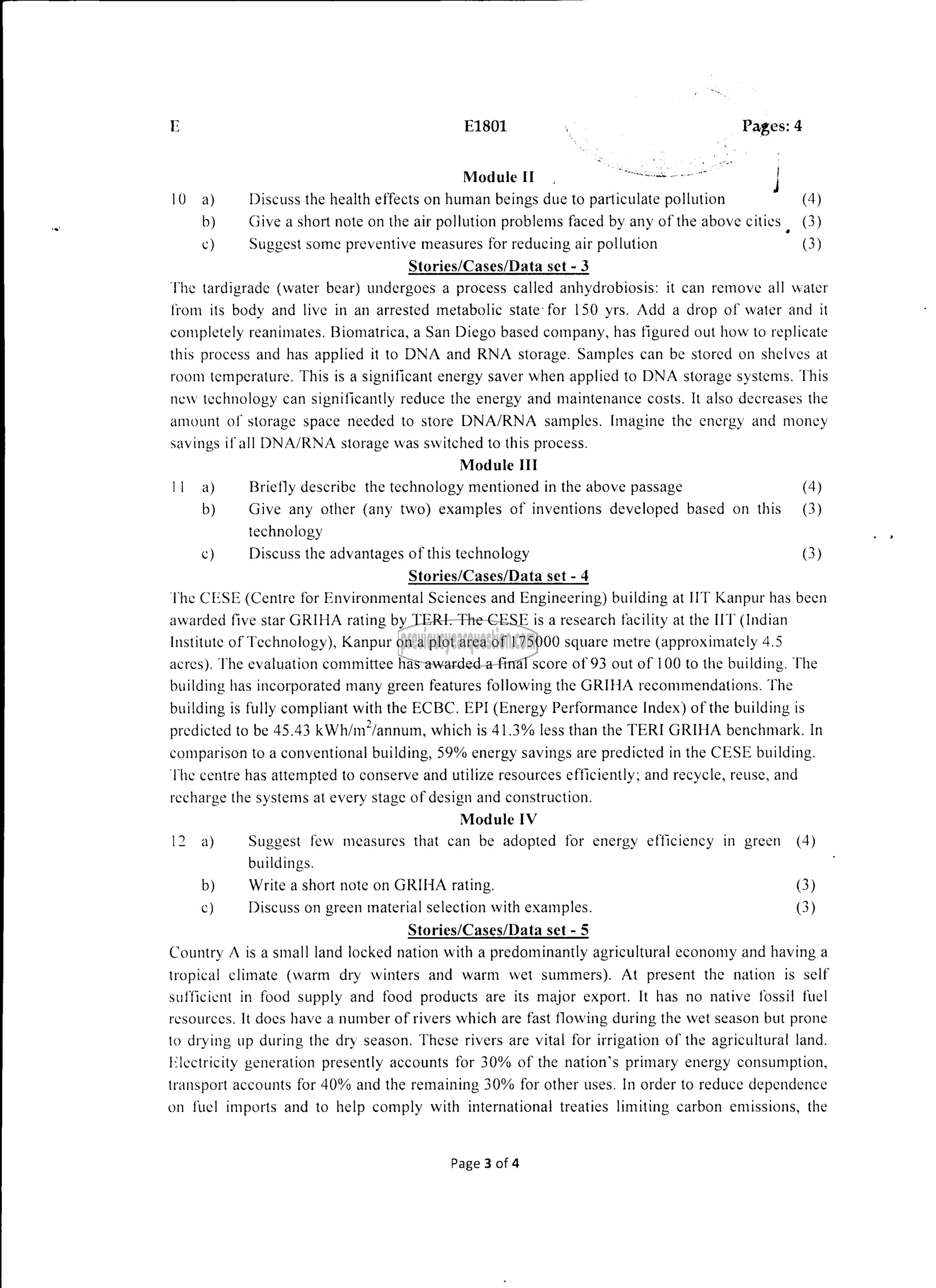APJ ABDUL KALAM TECHNOLOGICAL UNIVERSITY Previous Years Question Paper & Answer
Semester : S1 and S2
Subject : INTRODUCTION TO SUSTAINABLE ENGINEERING
Year : 2018
Term : APRIL
Branch : MECHANICAL ENGINEERING
Scheme : 2015 Full Time
Course Code : BE 103
Page:3
3 E1801 ١ Pages: 4
Module 11 , സൈ |
10 a) Discuss the health effects on human beings due to particulate pollution (4)
b) Give a short note on the air pollution problems faced by any of the above cities , (3)
௦) Suggest some preventive measures for reducing air pollution (3)
Stories/Cases/Data set - 3
The tardigrade (water bear) undergoes a process called anhydrobiosis: it can remove all water
from its body and live in an arrested metabolic 51810: for 150 yrs. Add a drop of water and it
completely reanimates. Biomatrica, a San Diego based company, has figured out how to replicate
this process and has applied it to DNA and RNA storage. Samples can be stored on shelves at
room temperature. This is a significant energy saver when applied to DNA storage systems. This
new technology can significantly reduce the energy and maintenance costs. It also decreases the
amount of storage space needed to store DNA/RNA samples. Imagine the energy and money
savings if all DNA/RNA storage was switched to this process.
Module 111
11 a) Briefly describe the technology mentioned in the above passage (4)
b) Give any other (any two) examples of inventions developed based on this (3)
technology
८) Discuss the advantages of this technology (3)
Stories/Cases/Data set - 4
The CESE (Centre for Environmental Sciences and Engineering) building at IIT Kanpur has been
awarded five star GRIHA rating by TERI. The CESE is a research facility at the IIT (Indian
Institute of Technology), Kanpur on a plot area of 175000 square metre (approximately 4.5
acres). The evaluation committee has awarded a final score of 93 out of 100 to the building. The
building has incorporated many green features following the GRIHA recommendations. The
building is fully compliant with the ECBC. EPI (Energy Performance Index) of the building is
predicted to be 45.43 kWh/m?/annum, which is 41.3% less than the TERI GRIHA benchmark. In
comparison to a conventional building, 59% energy savings are predicted in the CESE building.
The centre has attempted to conserve and utilize resources efficiently; and recycle, reuse, and
recharge the systems at every stage of design and construction.
Module IV
12 a) Suggest few measures that can be adopted for energy efficiency in green (4)
buildings.
b) Write a short note on GRIHA rating. (3)
८) Discuss on green material selection with examples. (3)
Stories/Cases/Data set - 5
Country A is a small land locked nation with a predominantly agricultural economy and having a
tropical climate (warm dry winters and warm wet summers). At present the nation is self
sufficient in food supply and food products are its major export. It has no native fossil fuel
resources. It does have a number of rivers which are fast flowing during the wet season but prone
to drying up during the dry season. These rivers are vital for irrigation of the agricultural land.
Electricity generation presently accounts for 30% of the nation’s primary energy consumption,
transport accounts for 40% and the remaining 30% for other uses. In order to reduce dependence
on fuel imports and to help comply with international treaties limiting carbon emissions, the
Page 3 of 4
